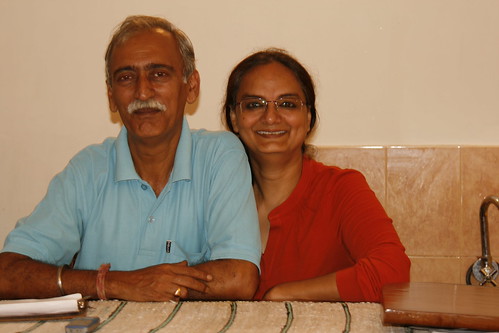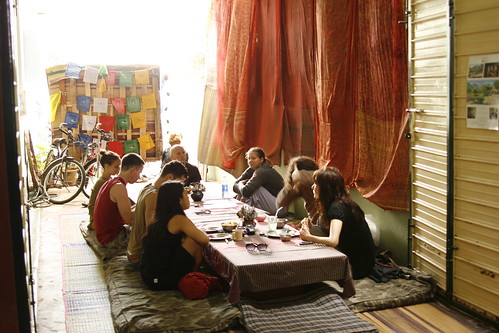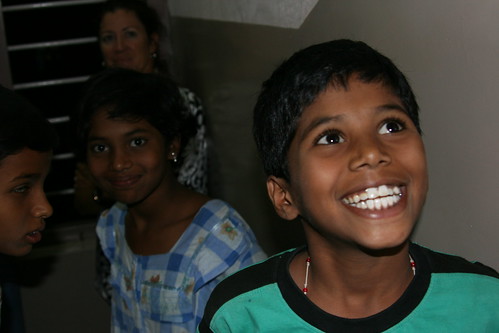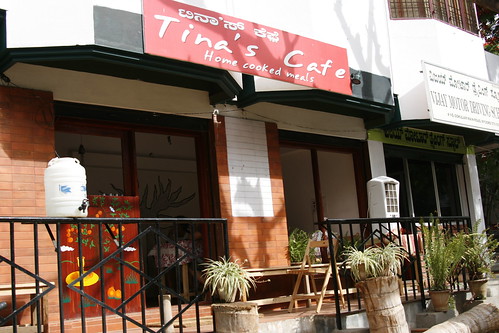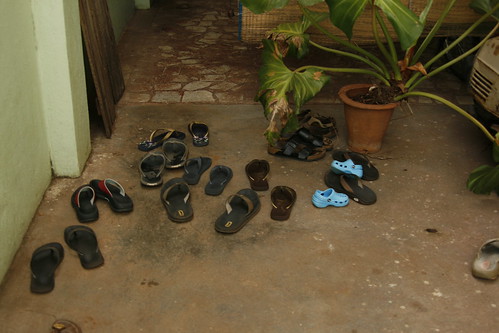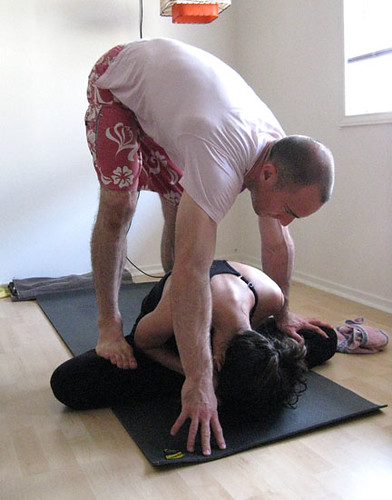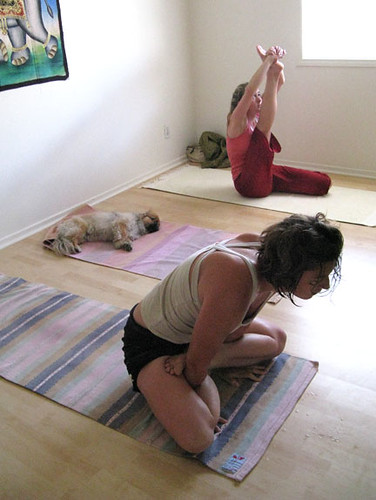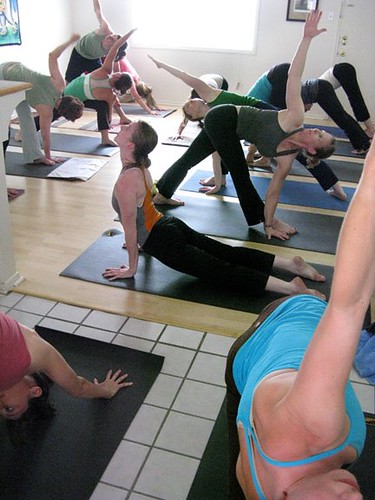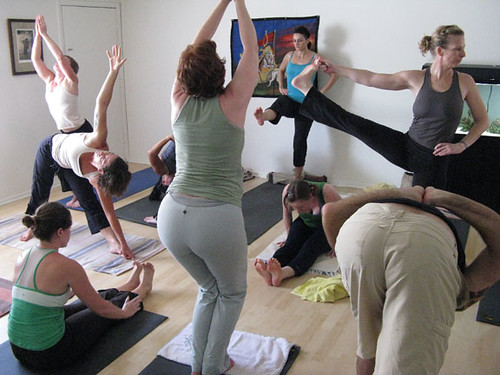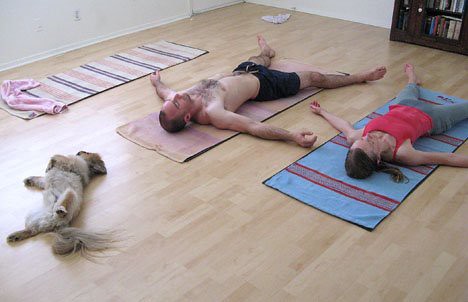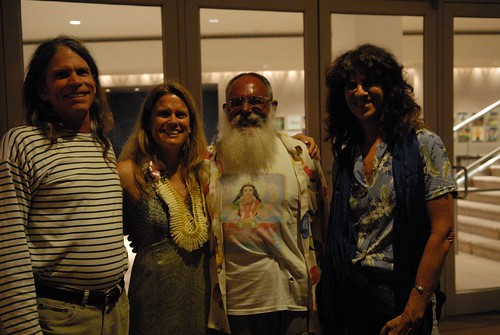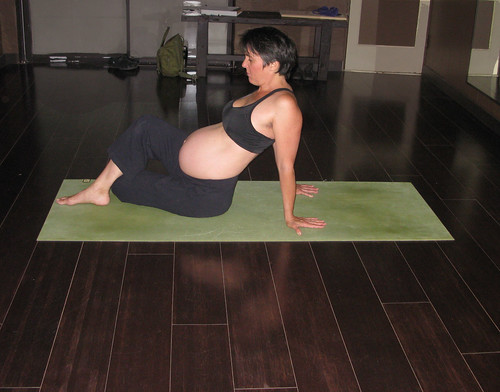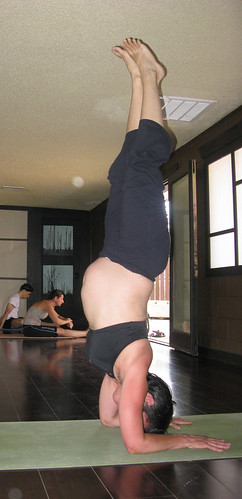by Krista ShirleyWhether you need to use the internet, grab lunch, dinner or a snack, arrange a car to take or pick you up from the airport, arrange a tour, exchange money, or find accommodations – Ganesh and Anu are the people to see! This lovely couple has been assisting yogis in Mysore with all their various needs since 2004.

Ganesh is the only child of a Brahman family. His mother tongue is Telugu but he learned Hindi and Kannada when his family moved from Coorg to Mysore at the age of nine. Anu, a Zoroastrian, was born in Bombay. Her heritage is a fascinating one to say the least. Zoroastrians originated in Persia, but were forced to relocate elsewhere, and many found refuge in Bombay. Her mother tongue is Gujarati but she became fluent in Kannada when her family moved to Mysore.
Ganesh and Anu’s story began when they met at the Mahajana’s College at age sixteen. It was love at first sight! Sadly, Ganesh’s father, Nagaraj, forbid their relationship because Anu was neither a member of the Brahman cast, nor a Hindu. In an attempt to end Ganesh and Anu's courtship, Nagaraj moved Ganesh and his entire family to Bangalore when Ganesh was seventeen. But this didn’t stop the love-struck couple! Ganesh finished his Bachelor’s degree in Science (B.Sc.) in Bangalore, and Anu finished her B.Sc. in Chemistry, Botany, and Zoology in Mysore, but they continued to sneak around to see one another. Ganesh would make trips to Mysore and Anu would come to Bangalore – all without Nagaraj’s knowledge. Oh the things we do for love!
After graduation Ganesh got a job in Bangalore with Godrej & Boyce, where he remained from 1980-1984. Upon graduation from college in Mysore, Anu moved to Bangalore, took a six month secretarial course and then took a job in Bangalore. Because Ganesh wanted to maintain peace in his own family he and Anu continued secretly to see each other. Ganesh went as far as joining law school simply to have an excuse to get out of his father's house to see Anu – he did not attend even one of the law classes his Nagaraj paid for!
But Anu’s parents, who liked Ganesh and did not care about their religious and cultural differences, believed it was high time they get married. After six years of dating Ganesh and Anu married in a civil court in front of a judge. Ganesh wanted to make their union legal in the event Ganesh’s father refused to agree to their marriage. No one, except Anu’s parents, knew about their civil marriage. A few months later Ganesh finally confronted his father, in a public park to reduce the possibility of a scene, to tell him that he intended to marry Anu. Ganesh’s father agreed, under the condition that Anu change her name from Aban (meaning August in Persian) to Anu. Ganesh’s father was ashamed of Anu’s cultural and religious differences and wanted to make Anu as much like a true Hindu as possible. The name "Anu" originates from Anuradha, which means a star, and Anu was also the name of one of Krishna’s girlfriends.
Their marriage ceremony lasted three days. In order for Ganesh’s father to be comfortable, Nagaraj’s own sister and her husband sat with Anu during the wedding ceremony so they could make believe they were her parents and she was Hindu. Anu’s parents were allowed to attend the wedding, but were not introduced to anyone. Following Hindu tradition Anu and Ganesh moved into his parent’s home after the wedding. Anu converted to Hinduism. She learned Telugu, and she was allowed to wear only a Sari.

Anu and Ganesh’s daughter, Brunda, was born in Bangalore. Not long after her birth, Ganesh got a job in Muscat, the capital of Oman, selling furniture for Mohsin Haider Darwish. At first Ganesh had to move alone, Anu and Brunda stayed behind in Bangalore with his parents. Ganesh furnished a house for a gentleman who offered to hire Anu to come work for him. This provided the visa Anu needed to move to Muscat with Ganesh. Brunda couldn’t come at first, so Ganesh’s parents looked after her. When Brunda was six, she joined Ganesh and Anu in Muscat and in 1990, their son Bharat was born. In 1993, Ganesh and Anu bought the house they currently occupy in Mysore, but they continued living in Muscat until 1997. The same year they purchased their Mysore home, Ganesh’s father, Nagaraj, passed away. In 1997 Bharat and Ganesh moved back to Mysore, and Anu and Brunda joined them the following year.
Upon returning to Mysore, Ganesh took a job working with a recruitment agency sending people to the Middle East to work and Anu worked as an administrative officer for a local company. In 2003, Ganesh and Anu opened Ganesh Bhavan, a restaurant just outside of town on the way to Ooty. They did really well, but had to sell the restaurant once Anu’s Bamboo hut became too demanding.
Anu’s Bamboo Hut opened in 2004. A yoga student living with Anu and Ganesh urged them to offer lunch and dinner to yoga students because no one was at the time. After some investigation and thought, Anu and Ganesh went to the local Bamboo Bazaar and ordered a custom made Bamboo Hut for the rooftop of their house. Shortly thereafter, Anu’s Bamboo Hut opened!
The growth of Anu’s Bamboo Hut was all via word of mouth. Yoga students spread the word to others and Anu’s Bamboo Hut quickly became a favorite spot among yogis. Anu serves delicious and healthy home cooked meals, buffet style, for lunch and dinner, Friday through Wednesday. Anu usually prepares a soup, 3 salads, dal, rice, chapattis, 3 cooked vegetable dishes, and she always tops off the meal with an amazing Indian desert!
Lunch is served from 1pm and Dinner from 5pm. They also offer the world's most amazing vegan chocolate banana pie, smoothies, masala chai, ginger lemon tea, coffee and milk, black tea/black coffee, lassi's and an assortment of other treats throughout the day on request.
The birth of Anu’s Internet café came shortly after Anu’s Bamboo Hut. Ganesh noticed the need for a good internet café – there were only two or three at the time but the number of computers and the internet speed were extremely limited. With a desire to offer the highest standard, to be the best internet café around, Ganesh sold his car and took out a bank loan so he could purchase fast computers and a fast internet connection. Ganesh offers high-speed broadband internet and Wi-Fi wireless internet connection for laptops – all for 20 rupees per hour, 10 rupees per half hour. Anu’s Internet Café also offers CD writing, DVD writing, voice chat, webcam- Skype, and laser printing.
In addition to meals and internet, you can see Ganesh if you need to find accommodations in Mysore, if you need to exchange money, want to take a tour, or if you need taxi service to or from the Bangalore airport. Ganesh offers spectacular taxi services in your choice of Tata Indigo car, a Tata Indica car, or an Ambassador car. If you wish to get dropped from Mysore to the new Bangalore International Airport the fare is Rs. 2000/- Add Rs.200 for Air-conditioned car. The fare for pickup from the new Bangalore International Airport to Mysore is Rs. 2100/- Add Rs.200 for Air-conditioned Car. If you would prefer to be dropped or picked up from the new Bangalore International Airport in a 4X4 Wheel drive Jeeps/Van (Tata Sumo, Chevrolet tavera, Chevrolet Tavera deluxe (all seats facing front and seat belts to all seats) expect to pay a bit more. And on prior intimation other Luxury Cars can be arranged.
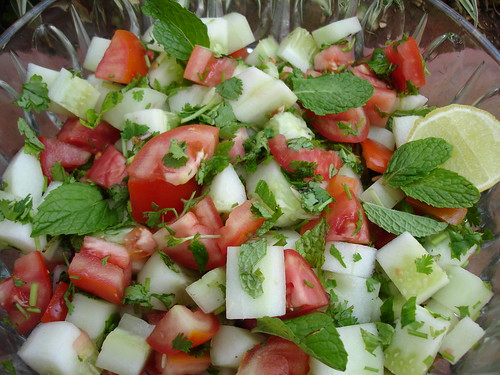
Ganesh also arranges site seeing tours in and around Mysore - Chamundi Hill, Mysore Zoo, Mysore Palace, JaganMohan Palace, Brindavan Gardens, Srigangapatna - Tippu Sultan's Fort, and the Bird Sanctuary. He can arrange out of town tours to Bylacuppe (Tibetan settlement), the Kabini Jungle resort and Bandipur Forests, Coorg, Belur, Halebid and Sravanabelagola. If you wish to travel to destinations outside Karnataka such as Chennai, Tamil Nadu and the Kerala beaches Ganesh can help you with that as well.
Anu and Ganesh are wonderful people who have, throughout their entire lives, and against all odds, followed their dreams. And they are some of the most caring and giving individuals I've ever had the pleasure to call my friends. Both in the yoga community, and in the local community, Anu and Ganesh open their doors and their hearts to lend a hand, offer advice, and provide food and shelter. And they aren't short on jokes either, Anu and Ganesh have such a joyful, happy, and humorous outlook on life - they can have you rolling on the floor laughing in stitches one minute, and holding your tummy satisfied by Anu's tasty meals the next. Needless to say, Anu and Ganesh Rock! So next time you need to find accommodations, use the internet, grab a bite to eat, or catch a taxi be sure you stop in and speak to Ganesh and Anu!
Anu’s Bamboo Hut and Anu’s Internet Cafe367, 2nd Main, 3rd Stage
Gokulam, Mysore
Karnataka, India 570 002
Email: anugan@gmail.com or ganeshmysore@gmail.com
Phone: 0821 4288120
Krista is currently practicing in Mysore, India. She writes the blog "AshtangaYogini".

